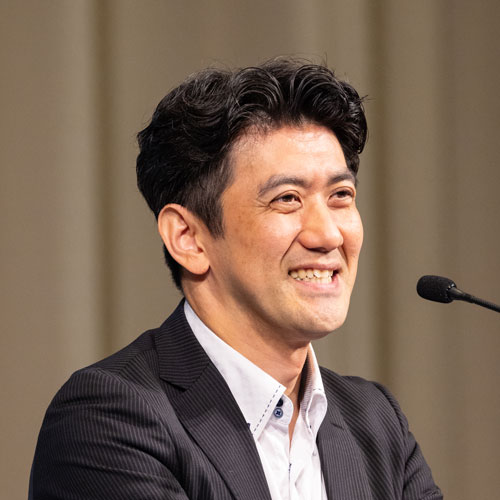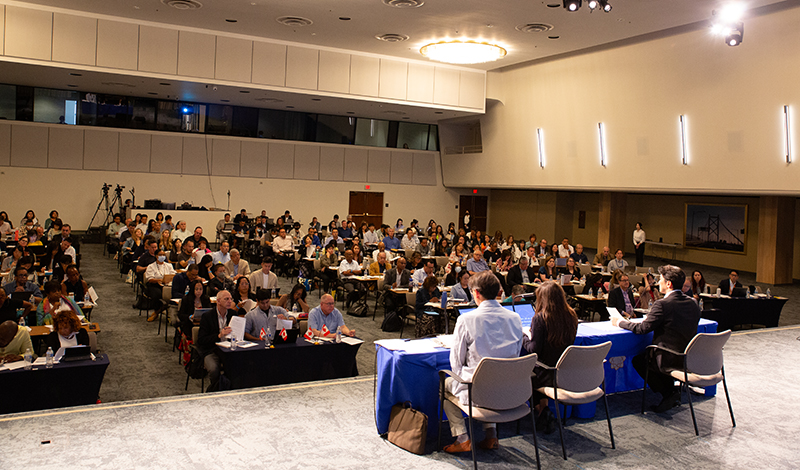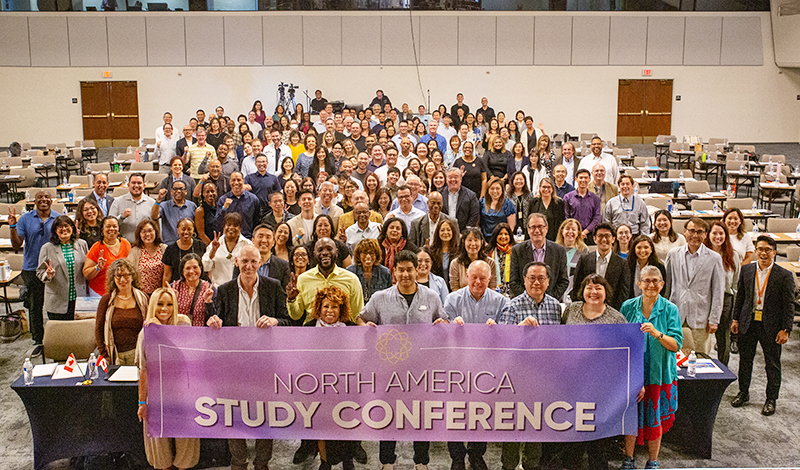SANTA MONICA, Calif.—On Aug. 26, 2023, some 190 representative men’s and women’s leaders from the five Southern California zones and SGI-Canada gathered at the World Peace Ikeda Auditorium in Santa Monica, California, to take part in the first, daylong session of the North America Study Conference, led by SGI Study Department Leader Seiichiro Harada.

On the following day, Mr. Harada led the second session of the study conference, attended by representative youth leaders (see coverage in an upcoming issue).
In a message to the conference, Ikeda Sensei touched on the significance of this year, which marks the 10th anniversary of the opening of the Hall of the Great Vow for Kosen-rufu in Shinanomachi, Tokyo. In its lobby, he noted, stands a monument whose dedication includes the following words: “If Nichiren’s compassion is truly great and encompassing, Nam-myoho-renge-kyo will spread for ten thousand years and more, for all eternity” (“On Repaying Debts of Gratitude,” The Writings of Nichiren Daishonin, vol. 1, p. 736).
Sensei continued:
In the place where you have vowed to carry out your mission, please “regard both suffering and joy as facts of life and continue chanting Nam-myoho-renge-kyo” (“Happiness in This World,” WND-1, 681). I also ask that you advance powerfully while on good terms with one another as you joyfully challenge yourselves to talk with your friends about Buddhism and build a happy and peaceful treasure land of the people.
On Aug. 26, Mr. Harada presented lectures on Nichiren’s writings “Letter from Sado” and “On Establishing the Correct Teaching for the Peace of the Land” in the first North America Study Conference to be held since 2019. The first lecture was broadcast live to leaders in 99 locations throughout the U.S. and Canada.
For Mr. Harada, the two-day conference was his first overseas assignment since being appointed as the SGI Study Department leader in June 2022. In opening the first lecture, he expressed how honored he was to support the study conference here in the U.S., which he called “the source of energy and inspiration for worldwide kosen-rufu.”
“Through this study conference,” he said, “I’d like to engrave the writings of Nichiren Daishonin in my life, together with all of you, and sincerely study the spirit and guidance of Sensei.”
Overcoming Great Obstacles Is the Key to Transforming Our Karma
During a bitterly trying period in Daisaku Ikeda’s youth, at a time when he suffered from tuberculosis and his mentor’s businesses faced serious setbacks, from where did he draw his spiritual strength?
“I read ‘Letter from Sado’ again and again,” he recalled, “drawing from it the courage to struggle on and make it through each day, and ultimately to realize victory.”[1]
In the first of two lectures given by Soka Gakkai Study Department Leader Seiichiro Harada on Aug. 26, the participants studied Nichiren Daishonin’s writing “Letter from Sado,” from Sensei’s commentary Learning From Nichiren’s Writings: The Teachings for Victory, vol. 1.
Mr. Harada explained that Sensei had called this letter “the writing for the Soka Gakkai”[2] that the three founding presidents, united by the eternal bonds of mentor and disciple, engraved in their lives “as a source of spiritual inspiration and sustenance.”
Why? Because it’s a work that teaches us “how to uphold the heart of a lion king and transform one’s karma,” Mr. Harada said.
Nichiren wrote this letter to his disciples in Kamakura at a time of intensifying persecution. He had been banished to Sado Island, a harsh and, at times, bitterly cold place of exile, from which he wasn’t expected to return. He nevertheless conveyed the deepest concern for the well-being of his disciples in this letter.
Mr. Harada asked the participants to imagine this letter arriving from Sado Island, where the Daishonin had been exiled. “To his disciples in Kamakura, this must have been like a single ray of light piercing the darkness,” he said. “I imagine them huddling close together as they read it over and over.”
In its pages was the mentor’s impassioned call, like a lion’s mighty roar, to his disciples to never give in to defeat in times of adversity.
The Latter Day—a Time of Confusion and Uncertainty
Nichiren opens the letter with the following depiction:
The most dreadful things in the world are the pain of fire, the flashing of swords, and the shadow of death. Even horses and cattle fear being killed; no wonder human beings are afraid of death. Even a leper clings to life; how much more so a healthy person.[3]
Mr. Harada equated the “pain of fire” to the accidents and natural disasters we experience today and the “flashing of swords” to violence and war.
“The Latter Day is an age when Buddhist values, which should serve as the spiritual foundation of society, are uprooted, and in the resulting confusion and uncertainty, the true message of Buddhism is steadily lost,” he said.
During the Daishonin’s time, high-ranking priests responsible for clarifying the Buddha’s teachings had become corrupt, working in league with the authorities to remove any threat to their power. For this reason, a sage, or a person of wisdom, who upheld the correct teachings, would be subject to persecution, along with their followers.
Nichiren writes of these priests:
It is the nature of beasts to threaten the weak and fear the strong. Our contemporary scholars of the various schools are just like them. They despise a wise man without power, but fear evil rulers. They are no more than fawning retainers. Only by defeating a powerful enemy can one prove one’s real strength.[4]
“The Daishonin declares with great conviction that this time of the Law’s decline is precisely when we must forge ahead with the heart of a lion king to protect the Law, undaunted by persecution,” Mr. Harada said.

‘Like Nichiren, for Example’
The Latter Day of the Law is a time when the enemies of the Lotus Sutra abound and the world of animality predominates. During the Daishonin’s time, the priest Ryokan of Gokuraku-ji vied with him to pray for rain and lost. He then went to the authorities and leveled accusations at Nichiren that resulted in his near-execution during the Tatsunokuchi Persecution, followed by his exile to Sado Island.
Nichiren writes:
When an evil ruler in consort with priests of erroneous teachings tries to destroy the correct teaching and do away with a man of wisdom, those with the heart of a lion king are sure to attain Buddhahood. Like Nichiren, for example. I say this not out of arrogance, but because I am deeply committed to the correct teaching.[5]
Through this letter, Nichiren shows his followers how to carry out Buddhist practice in the Latter Day and stand up with the same resolve that he upheld.
The statement “Like Nichiren, for example” not only reveals Nichiren’s life state during intense persecutions but also serves as a call to his disciples to carry on this same spirit.
Sensei elaborates:
His words, “Like Nichiren, for example,” represent a passionate cry to his disciples. We can imagine him calling out to the depths of their being: “Just as I defeated all devilish forces, you, too, must summon the heart of a lion king and win over all negative forces. Fight with the same spirit as Nichiren! Fight alongside me, and with the same resolve!” He was waiting for dedicated disciples to stand up with the same spirit and commitment that he had.[6]
Summon the Heart of a Lion King
What does the Daishonin mean when he calls on his disciples to summon the “heart of a lion king”?
Mr. Harada shared that the lion’s roar of which he speaks is the mentor and disciple chanting daimoku in unison as they propagate the Mystic Law.
As the Daishonin says:
The Record of the Orally Transmitted Teachings says: The lion’s roar (shishi ku) is the preaching of the Buddha. The preaching of the Law means the preaching of the Lotus Sutra, or the preaching of Nam-myoho-renge-kyo in particular.
The first shi of the word shishi, or “lion” [which means “teacher”], is the Wonderful Law that is passed on by the teacher. The second shi [which means “child”] is the Wonderful Law as it is received by the disciples. The “roar” is the sound of the teacher and the disciples chanting in unison.
The verb sa, “to make” or “to roar,” should here be understood to mean to initiate or to put forth. It refers to the initiating of Nam-myoho-renge-kyo in the Latter Day of the Law.[7]
In his lecture, Sensei says the following regarding this point:
The wish of the lion king—the Buddha—as taught in Nichiren Buddhism is to triumph over every manner of devilish function and enable all people to realize happiness through the great lion’s roar that has the power to move everything in a positive direction.
The Daishonin teaches us here that the essence of this lion’s roar is the shared struggle of mentor and disciple. …
Kosen-rufu is a spiritual struggle to fundamentally vanquish the destructive impulses that reside in the depths of people’s lives and cause them unhappiness. That is why forces hostile and resentful toward the Soka Gakkai, which holds high the banner of the Mystic Law, have attacked us in every conceivable way, attempting to destroy our movement. But, linked by the bonds of mentor and disciple, we have always triumphed by speaking out together for what is right.
The great united lion’s roar of mentor and disciple allows us to vanquish fundamental ignorance and powerfully draw forth the fundamental nature of enlightenment, or Dharma nature.[8]
Mr. Harada said the “roar of a lion” is precisely that—the cry of the king of beasts. “In the various Buddhist scriptures, it is symbolic of the Buddha’s fearless composure when speaking the truth,” he said.
During the assembly of the Lotus Sutra, Shakyamuni’s disciples make a vow in response to their mentor’s call to propagate the Lotus Sutra after his passing. They choose to express their resolve by “[roaring] the lion’s roar.”[9]
Prior to this, the “lion’s roar” was ascribed to the Buddha himself, but here, the disciples embrace it to express their own vow.
Mr. Harada explained how the Latter Day of the Law is a time after the Buddha’s passing when those living in the saha world are not only viewed as being inferior in their capacity to understand the Law but are also surrounded by the “three powerful enemies”[10] and the “three obstacles and four devils.” [11]
Who are the disciples who will rise up in the most difficult times to advance kosen-rufu? The Soka Gakkai members, fellow Bodhisattvas of the Earth, who have forged ahead in their efforts for kosen-rufu alongside the three founding presidents.
“Only when the disciple inherits the mentor’s wish to achieve kosen-rufu and fights for its realization can it be carried on eternally,” Mr. Harada said. “This is a core message that consistently runs throughout the entire Lotus Sutra.”
As disciples who are engaged in a shared struggle with Sensei, “you are the most trusted forces for good,” Mr. Harada added. “Because of the profound bond we share with our mentor, we have emerged in this most troubled time to realize kosen-rufu.”
A Practice to Change Our Destiny
In the latter half of “Letter from Sado,” Nichiren examines the Buddhist principle of transforming one’s karma or destiny, offering hope for all humanity. He writes:
Iron, when heated in the flames and pounded, becomes a fine sword. Worthies and sages are tested by abuse. My present exile is not because of any secular crime. It is solely so that I may expiate in this lifetime my past grave offenses and be freed in the next from the three evil paths.[12]
This passage expresses the principle of changing one’s karma or destiny, which is a core concept in Nichiren Buddhism. When iron is struck repeatedly in intense heat, its impurities are removed, and it is forged into highly resilient steel. Then the iron is crafted into a sharp blade.
Mr. Harada called this an analogy for a person’s battle against adversity and how we can forge more resilient lives by hammering out our negative karma within through Buddhist practice.
Sensei, in his second Harvard University lecture, titled “Mahayana Buddhism and Twenty-First-Century Civilization,” raised the questions:
Does religion make people stronger, or weaker? Does it encourage what is good or what is evil in them? Are they made wiser or less so by religion?
Making people strong, good and wise is the essence of Nichiren Buddhism. In this age of widespread inhumanity, the need is greater than ever before for this human-centered religion.[13]
“To make people strong, good and wise—there are no other words that so concisely express the essential quality of Nichiren Buddhism,” Mr. Harada said.
Changing Karma Into Mission
Mr. Harada highlighted three characteristics of changing karma in Nichiren Buddhism:
1) Our suffering is a result of our karma. By transforming our state of life, we transform our karma and free ourselves from suffering. Our happiness and suffering are not determined by external forces. Rather, it is our attitude and behavior that determine the outcome of our lives.
2) Nam-myoho-renge-kyo has the power to transform any negative karma. Anyone can transform their karma, or change their destiny, right where they are and without changing who they are.
3) Transforming our karma proves the power of Buddhist practice. The drama of human revolution reveals the potential that we have as human beings, a drama that can encourage others to reveal their own potential.
Sensei discusses each of these points as follows:
Basing ourselves on the Lotus Sutra means recognizing that we and all people possess a noble life state equal to the Buddha. When the sun rises, it dispels the darkness and brightly illuminates the world. Similarly, when we chant Nam-myoho-renge-kyo, we bring the sun of our inherent Buddhahood from time without beginning to shine within us. As a result, the darkness of fundamental ignorance evaporates, past karma is transformed, and we are filled with the elemental power to conquer all suffering and hardship.
At that moment, the meaning of karma changes. Our life of suffering caused by karma undergoes a major transformation, becoming a life of challenging our negative karma and demonstrating genuine human value and dignity. This is the essence of Nichiren Buddhism, which teaches the principle of “changing karma.” Here, we find the key to revitalizing our lives and creating a brighter future.[14]
Even during this time of crisis, characterized by the COVID-19 pandemic and the war in Ukraine, Soka Gakkai members throughout the world are forging ahead with the hope-filled resolve to change their karma into mission.
“Above all, you are chanting the lion’s roar of daimoku as you proudly engage in a shared struggle with your mentor in the place where you live,” Mr. Harada concluded. “Each of you has a sublime mission.”
—Prepared by the World Tribune staff
September 8, 2023, World Tribune, pp. 7
References
- The Teachings for Victory, vol. 1, pp. 1–2. ↩︎
- Ibid., p. 1. ↩︎
- “Letter from Sado,” The Writings of Nichiren Daishonin, vol. 1, p. 301. ↩︎
- Ibid., p. 302. ↩︎
- Ibid. ↩︎
- The Teachings for Victory, vol. 1, p. 14. ↩︎
- he Record of the Orally Transmitted Teachings, p. 111. ↩︎
- A Religion of Human Revolution, pp. 178–79. ↩︎
- The Lotus Sutra and Its Opening and Closing Sutras, p. 232. ↩︎
- Three powerful enemies: Three types of arrogant people who persecute those who propagate the Lotus Sutra in the evil age after Shakyamuni Buddha’s death. They are: 1) arrogant lay people, 2) arrogant priests and 3) arrogant false sages. ↩︎
- Three obstacles and four devils: Various obstacles and hindrances to the practice of Buddhism. The three obstacles are: 1) the obstacle of earthly desires, 2) the obstacle of karma and 3) the obstacle of retribution. The four devils are: 1) the hindrance of the five components, 2) the hindrance of earthly desires, 3) the hindrance of death and 4) the hindrance of the devil king. ↩︎
- WND-1, 303. ↩︎
- January 2022 Living Buddhism, p. 57. ↩︎
- Ibid., pp. 57–58. ↩︎
You are reading {{ meterCount }} of {{ meterMax }} free premium articles

